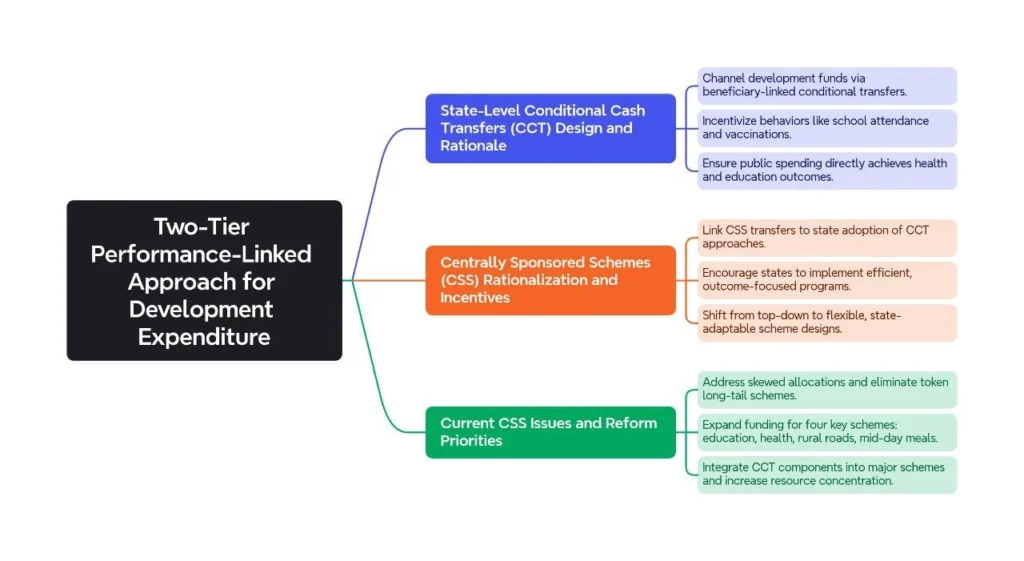Paper: GS – III, Subject: Economy, Topic: Growth and Development, Issue: Speeding Up Development in Lagging States.
Context:
India’s development is uneven, with richer states having more resources and fiscal strength, while poorer states struggle financially and remain caught in a cycle of low revenue, limited spending, and poor development outcomes.
Key Highlights:
The Development Dilemma of Lagging States:
Several Indian states, including Assam, Bihar, Chhattisgarh, Jharkhand, Madhya Pradesh, Rajasthan, and Uttar Pradesh, face a significant development dilemma.
- These states exhibit lower levels of both economic and social development compared to other states. This situation is compounded by the following factors:
- Low Public Spending: The level of public spending in these states is comparatively very low.
- For instance, in 2022-23, per capita government spending of around ₹17,000 per capita in Bihar was only about one-fourth that of Himachal Pradesh at ₹67,700.
- Limited Fiscal Space: These states have limited capacity to increase public spending due to lower revenue receipts from their own sources.
- Bihar, for example, raises less than 30% of its total revenues from its own sources, compared to over 80% in Haryana.
- High Indebtedness: Their capacity to borrow is quite constrained, since their indebtedness (relative to gross state domestic product) is much higher on average at 31% compared to around 25% for better-off states.
- Constrained Borrowing Capacity: Their annual fiscal deficits, at around 3.4% on average, are also higher compared to 2.4% for better-off states and higher than permissible under the states’ fiscal responsibility and budget management laws.
- Existing Expenditure Allocation: These states already allocate a significant portion of their expenditure to capital and social sectors, comparable to or even higher than that of better-off states.
- Their average outlay for capital expenditure, at close to 16% of the total, is already higher than that of balanced development’ states and equal to that of growth-oriented states.
- Similarly, their allocation for social expenditure, at nearly 40% on average, is higher than that of growth oriented or ‘balanced development states and similar to the 41% share in social development’ oriented states.
Two-Tier Performance-Linked Approach for Development Expenditure:

By adopting a two-tier performance-linked approach that emphasizes conditional cash transfers and rationalizes centrally sponsored schemes, these states can improve the efficiency of government spending and achieve better development outcomes.
La Excellence IAS Academy, the best IAS coaching in Hyderabad, known for delivering quality content and conceptual clarity for UPSC 2025 preparation.
FOLLOW US ON:
◉ YouTube : https://www.youtube.com/@CivilsPrepTeam
◉ Facebook: https://www.facebook.com/LaExcellenceIAS
◉ Instagram: https://www.instagram.com/laexcellenceiasacademy/
GET IN TOUCH:
Contact us at info@laex.in, https://laex.in/contact-us/
or Call us @ +91 9052 29 2929, +91 9052 99 2929, +91 9154 24 2140
OUR BRANCHES:
Head Office: H No: 1-10-225A, Beside AEVA Fertility Center, Ashok Nagar Extension, VV Giri Nagar, Ashok Nagar, Hyderabad, 500020
Madhapur: Flat no: 301, survey no 58-60, Guttala begumpet Madhapur metro pillar: 1524, Rangareddy Hyderabad, Telangana 500081
Bangalore: Plot No: 99, 2nd floor, 80 Feet Road, Beside Poorvika Mobiles, Chandra Layout, Attiguppe, Near Vijaya Nagara, Bengaluru, 560040
